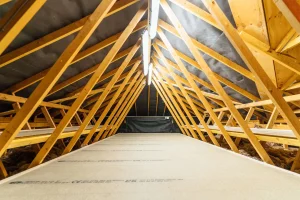Loft boarding refers to the installation of a solid floor in the loft space of a building. This technique is commonly used to create additional storage space or even extra living areas in homes. It involves laying down boards over the existing joists to create a usable floor. Understanding the weight limit for loft boarding is crucial to ensure the safety and durability of the installation. Exceeding the weight limit can lead to structural damage and potential safety hazards.
Factors Affecting the Weight Limit for Loft Boarding
Type of Loft Boarding Material
The materials used for loft boarding significantly impact its weight capacity. Common materials include wood and metal, each offering different levels of strength and support. For example, plywood and chipboard are popular choices for loft boarding due to their balance of strength and affordability. Metal options, though less common, provide superior durability and can support heavier loads. The choice of material directly influences how much weight the loft boarding can safely bear.
Structural Integrity of the Loft
The existing structural integrity of the loft plays a vital role in determining the weight limit. It’s essential to assess the strength of the joists and the overall framework before installing loft boarding. Weak or damaged joists can compromise the safety of the installation. Professional evaluations are highly recommended to accurately determine the load-bearing capacity of your loft and to identify any necessary reinforcements.
Design and Installation
Proper design and installation are critical for maximizing the weight limit of loft boarding. The way the boards are laid and secured affects the overall stability and strength of the loft floor. Ensuring that the boarding is correctly installed by professionals can prevent structural issues and enhance safety. Professional installers have the expertise to optimize the design and ensure that the weight is evenly distributed across the loft.
Load Distribution
Evenly distributing weight across the loft boarding is crucial to prevent overloading any single point. Concentrating too much weight in one area can cause the boards to sag or even break. To maintain structural integrity, heavy items should be spread out across multiple areas. Proper load distribution techniques help ensure that the loft can safely support the intended load without any risk of damage.
Standard Weight Limits for Loft Boarding
General Guidelines
Typical weight limits for loft boarding vary based on materials and installation quality. On average, professionally installed loft boarding can support around 25 to 30 kg per square meter. However, these limits can differ depending on the type of boards used and the overall construction of the loft. It’s essential to consult manufacturer specifications and professional guidelines to determine the exact weight limits for your specific installation.
Building Regulations and Codes
Adhering to local building regulations is essential for ensuring your loft boarding meets safety standards. These regulations often dictate the minimum requirements for structural support and weight limits, underscoring the importance of compliance. Building codes are designed to ensure that loft boarding installations are safe and durable, helping to prevent structural failures and accidents. It’s crucial to familiarize yourself with the relevant regulations in your area and ensure your loft boarding meets these standards.

Enhancing the Weight Capacity of Loft Boarding
Reinforcement Techniques
There are several methods to reinforce your loft structure and increase its weight capacity. Adding extra joists or using stronger materials can significantly enhance the strength of the loft floor. Reinforcement techniques such as installing additional support beams or cross-bracing can provide extra stability. While reinforcing your loft can increase the weight limit, it’s important to consider the associated costs and benefits.
Choosing High-Quality Materials
Opting for high-quality loft boarding materials can significantly impact the weight capacity. Durable materials such as high-grade plywood or engineered wood ensure better support and longevity. Investing in quality materials may be more expensive initially, but it pays off in terms of safety and durability. High-quality boards are less likely to warp or break under heavy loads, making them a worthwhile investment for any loft boarding project.
Professional Installation
Hiring professionals for installation guarantees that your loft boarding is set up correctly, maximizing its weight limit and ensuring safety. Professional installers have the expertise to handle complex installations and ensure that the boarding is securely fixed in place. They can also provide valuable advice on maintaining the loft and preventing overloading. Professional installation not only enhances the safety and functionality of your loft but also provides peace of mind knowing that the job is done right.
Common Misconceptions About Loft Boarding Weight Limits
Overestimating the Strength of Loft Boarding
One common misconception is overestimating the strength of loft boarding. Many people believe that loft boarding can support any amount of weight, leading to overloading. This can result in serious structural damage and safety risks. It’s essential to understand the actual weight limits and avoid exceeding them. Ignoring these limits can lead to costly repairs and potential hazards.
Ignoring Professional Advice
Ignoring professional advice on weight limits and structural integrity can lead to severe consequences. Some homeowners may attempt DIY installations without understanding the complexities involved. Professional guidance is crucial to ensure the safety and effectiveness of loft boarding. Experts can provide accurate assessments and recommend the best practices for your specific situation, helping to avoid potential issues down the line.

Safety Tips for Loft Boarding
Regular Inspections
Regular inspections of your loft boarding can help identify and address issues before they become significant problems. Look for signs of wear and tear, such as sagging boards or cracks, and address them promptly. Regular maintenance ensures that the loft remains safe and functional over time. Professional inspections can provide a more thorough assessment and identify potential issues that may not be visible to the untrained eye.
Proper Usage and Storage
Adopting safe storage practices is essential for maintaining the structural integrity of your loft boarding. Avoid placing excessively heavy items on the loft and distribute weight evenly to maintain balance and stability. Use shelving units or storage boxes to organize items and prevent them from piling up in one area. Proper usage and storage helps ensure that the loft can safely support the load without risking damage or collapse.
Understanding the weight limit for loft boarding involves considering various factors such as material types, structural integrity, design, and load distribution. Adhering to guidelines and professional advice ensures safety and optimal use of the loft space. Reinforcing the structure, choosing high-quality materials, and hiring professionals for installation can significantly enhance the weight capacity and safety of your loft boarding.

